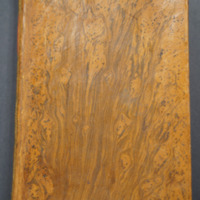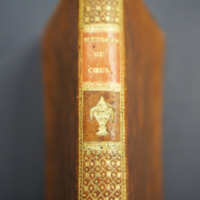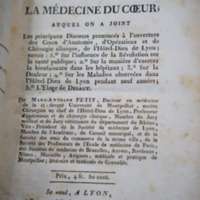Essai sur la médecine du coeur […]
Dublin Core
Title
Essai sur la médecine du coeur […]
Description
English
This is a tree-calf binding, with the tree-like appearance produced by pouring acid over the leather and the binding moved in a specific way to generate the desired pattern. Using a method that requires a high degree of mastery, the pattern is generated by pouring acid over polished leather. The collection at Archives and Special Collections contains several examples of this technique, one that would have been known to only a privileged few master binders. There are many designs generated onto bindings with the use of acid, the “marbled” effect being the most common. There is also an effect that simulates the mark of a cat’s paw.
Français
Cette reliure présente un motif célèbre de la décoration produite avec de l’acide à la fin du XVIIIe siècle, qu’on appelle veau raciné. Il s’agit d’une peau de veau qu’on a poli et sur laquelle on a déposé de l’acide afin de créer des motifs. Le motif de l’arbre que l’on voit ici demande une maîtrise technique très particulière. Notre collection comprend plusieurs exemples de cette technique qui ne s’apprenait que chez un certain nombre de maîtres relieurs. Il existe plusieurs autres motifs créés avec l’acide dont le motif marbré, le plus courant, ou encore le motif pattes de chat.
This is a tree-calf binding, with the tree-like appearance produced by pouring acid over the leather and the binding moved in a specific way to generate the desired pattern. Using a method that requires a high degree of mastery, the pattern is generated by pouring acid over polished leather. The collection at Archives and Special Collections contains several examples of this technique, one that would have been known to only a privileged few master binders. There are many designs generated onto bindings with the use of acid, the “marbled” effect being the most common. There is also an effect that simulates the mark of a cat’s paw.
Français
Cette reliure présente un motif célèbre de la décoration produite avec de l’acide à la fin du XVIIIe siècle, qu’on appelle veau raciné. Il s’agit d’une peau de veau qu’on a poli et sur laquelle on a déposé de l’acide afin de créer des motifs. Le motif de l’arbre que l’on voit ici demande une maîtrise technique très particulière. Notre collection comprend plusieurs exemples de cette technique qui ne s’apprenait que chez un certain nombre de maîtres relieurs. Il existe plusieurs autres motifs créés avec l’acide dont le motif marbré, le plus courant, ou encore le motif pattes de chat.
Creator
Petit, Marc Antoine (1766-1811)
Source
Archives and Special Collections, University of Ottawa [R 708 .P48 1806]/Archives et collections spéciales, Université d'Ottawa [R 708 .P48 1806]
Date
1806
Rights
Archives and Special Collections, University of Ottawa/Archives et collections spéciales, Université d'Ottawa
Format
Book/Livre
Language
French/Français
Type
Text/Texte
Identifier
ARSC_RB_R 708 .P48 1806
Collection
Citation
Petit, Marc Antoine (1766-1811), “Essai sur la médecine du coeur […],” Archives et collections spéciales, Bibliothèque d'Ottawa, accessed December 13, 2025, http://omeka.uottawa.ca/arcs/items/show/25.



